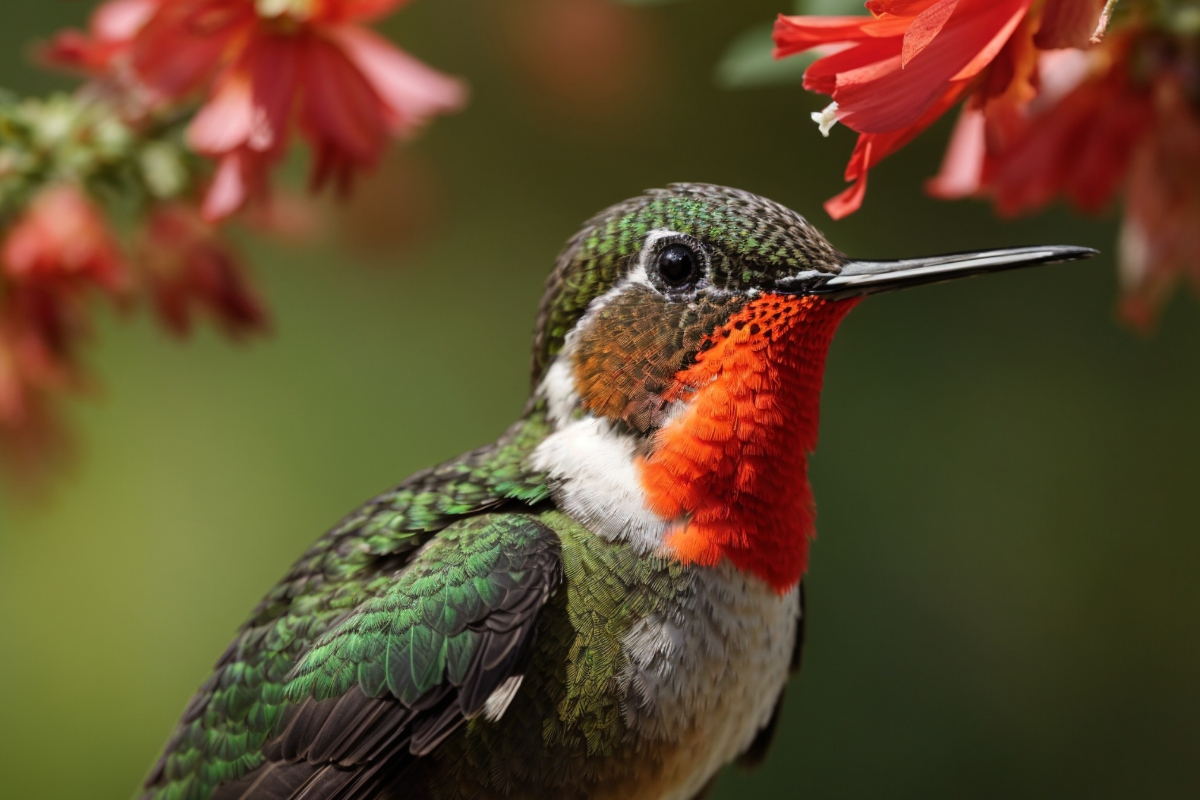Most hummingbirds depart Massachusetts between late August and mid-September. By the end of September, only a few remain. The peak departure coincides with the autumnal equinox around late September.
As the days shorten, their instinct to migrate to warmer regions like Mexico, Panama, and Costa Rica grows stronger.
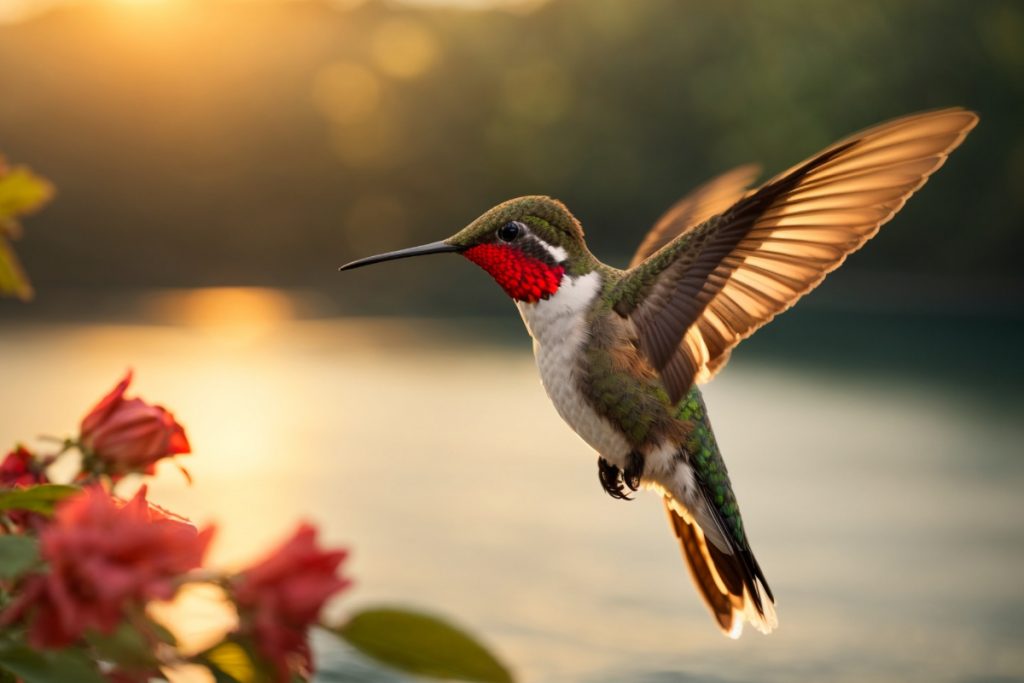
In this blog post, we’ll look at the interesting migration habits of hummingbirds in Massachusetts. Also, we will learn precisely when and why they head south each year and the best ways to keep enjoying their presence before they leave.
In addition, we will explore the history of hummingbirds in the state. I will also be sharing interesting facts about their yearly journeys and offer tips for preparing them for winter. Time to give our fair-feathered friends a proper goodbye!
Related post to read about Top Hummingbird Feeders.
Why Do Hummingbirds Leave Massachusetts for the Winter?
Hummingbirds are not adapted to cold weather; they retreat south, where they can continue to find the insects and nectar they need to survive.
A good example is the Ruby-throated hummingbirds; they love warm weather and plenty of food in places such as Central America and Mexico.
This saves them from the perils of remaining in frigid northern climates like Massachusetts’ through the winter.
Hummingbirds enter a hibernation-like state called torpor at night and on cold winter days. But unlike true hibernation, they can’t sustain this for very long.
To keep their turbo-charged metabolisms running, they need to eat regularly. They may even eat up to half their body weight every day!
So, as northern plants die off and insects become scarce, migration is truly a life-or-death matter for these tiny birds. Heading south is the only option for winter survival.

Fascinating Hummingbird Facts
Before we say farewell, let’s look at some cool facts about our favourite summer visitors:
- Ruby-throated hummingbirds weigh less than a nickel but can travel over 500 miles nonstop across the Gulf of Mexico in spring and fall migrations. Talk about determination!
- Hummingbirds are the only birds that can fly backwards and upside down. They can also hover in midair and reach speeds of over 50 mph in a dive bomb.
- Their wings beat a blistering 50-200 times per second, creating that trademark buzzing hum. This allows them to remain suspended in one place while feeding.
- A hummingbird’s heart rate can reach over 1,200 beats per minute. Their breathing rate tops 250 breaths per minute, even at rest. This supports their extreme energy needs.
- Hummingbirds sip nectar through uniquely adapted tongues that curl to form tiny straws, perfect for slurping up liquid from flowers.
- Males perform dramatic dive displays during the breeding season to impress females and fend off competitors from their territories.
- Hummingbirds build nests about the size of a walnut out of spider silk, moss, lichen, and other soft materials. They never cease to amaze me!
Hummingbird History in Massachusetts
While most people think of hummingbirds as a fixture of southern states, they have a long history in Massachusetts too. Here are some highlights:
- Native American groups like the Wampanoag incorporated hummingbird symbols into their artwork and legends. These tiny birds represented courage, energy, and purity of spirit.
- Early European settlers were awe-struck when they encountered hummingbirds, marvelling at their diminutive size and magic-like flying abilities.
- By the late 1800s, writers like Mark Twain were documenting hummingbirds in Massachusetts as the Ruby-throated variety we know today.
- Anna’s hummingbirds began appearing in the state in the 1960s as their range expanded north and east across North America.
- In the 1980s and 90s, Massachusetts forests matured enough to support nesting hummingbirds that then became summer residents. Feeders also enabled their numbers to rise.
- Today, hundreds of thousands of ruby-throats return to breed in Massachusetts each summer, bringing their beauty and playful energy to backyards and parks statewide.
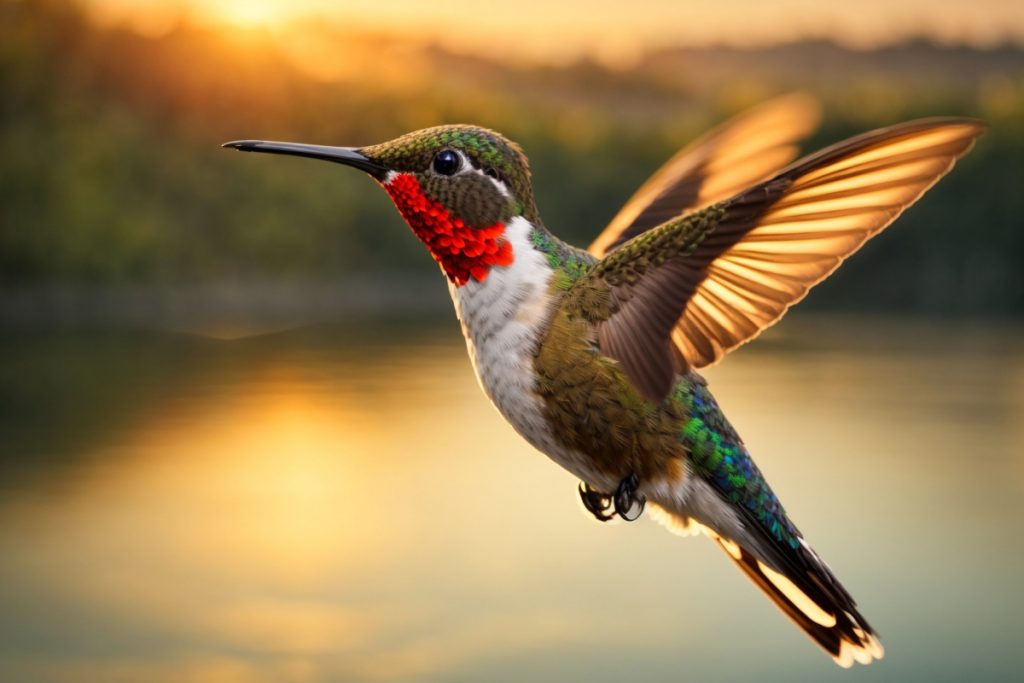
The Great Migration South
Now, let’s get back to the grand migration that takes hummingbirds away from Massachusetts every fall. Here are some key facts:
- In August, adult females and juveniles depart first, leaving the adult males temporarily behind to enjoy some late-summer bachelor time.
- Late August into September brings the peak departure period as most remaining adults sense the closing window for travel south.
- By mid-October, only a few stragglers remain in Massachusetts until the inevitable final push southward as the chill sets in.
- Ruby-throats drop weight before migrating, nearly halving their body mass by converting fat to fuel. A lighter load helps traverse huge distances.
- Some fly nonstop over 500 miles across the Gulf of Mexico, an incredible feat. Others follow coasts and islands in a series of shorter flights.
- Millions make the journey from as far north as Canada down through Florida, Mexico, and into Central America, funnelling through major flyways.
- Many dangers await along the way, from predators to storms to manmade obstacles. Tragically, 50% or more of fledglings may not survive their first migration.
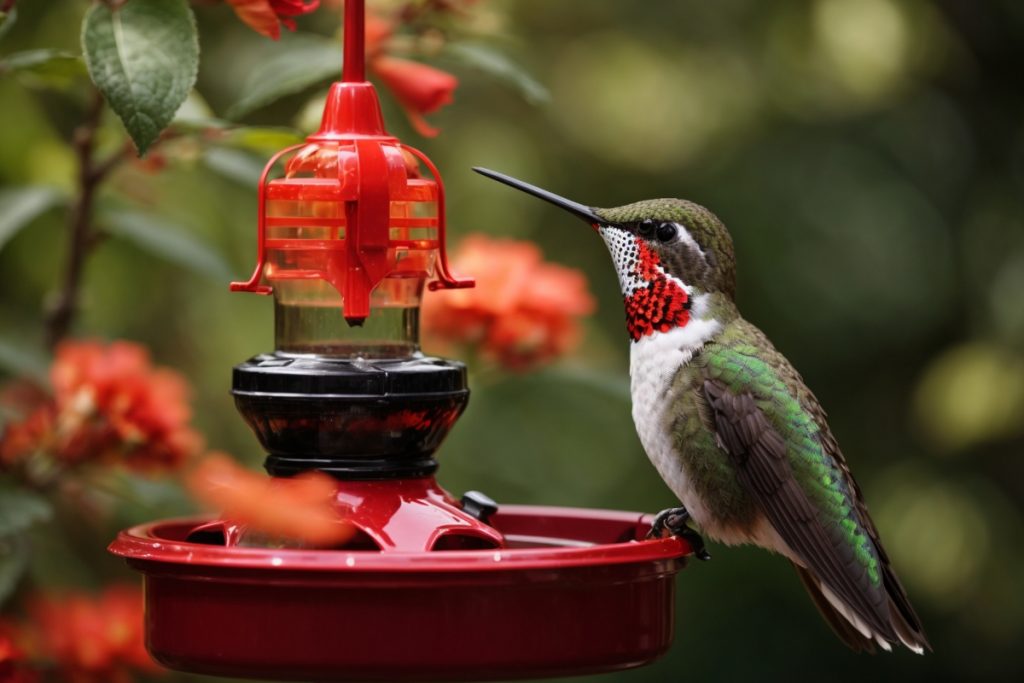
Lending a Hand Before They Leave
To help hummingbirds prepare for migration, make sure they have enough fuel and nourishment:
- Keep feeders freshly stocked through mid-September – the sugar water provides quick energy.
- Plant some late-blooming flowers like zinnias, cosmos, bee balm, and sage to supplement feeders.
- Avoid trimming plants too early so late-season blooms are available.
- Supply a mister for bathing and drink drips so they can preen and stay hydrated.
- Let some areas remain wild to provide insect food through early fall.
- Reduce the use of chemicals and pesticides that can leach into nectar sources.
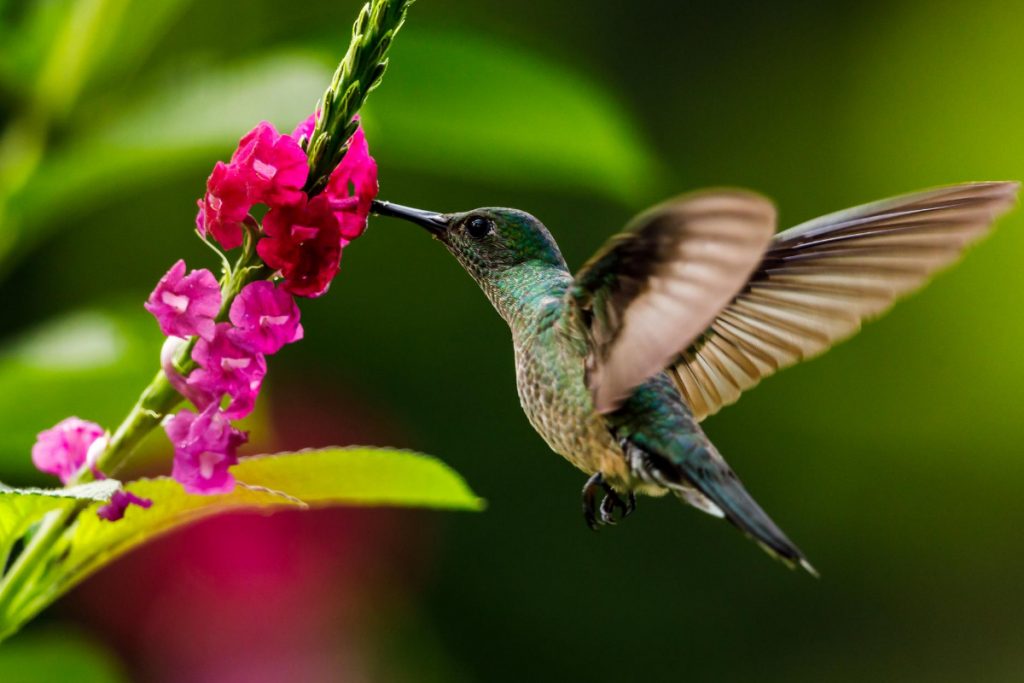
Giving Hummingbirds a Proper Send-Off
Don’t be sad when those small buzzing hummingbirds leave your garden in mid-September. Instead, celebrate!
You hosted fascinating creatures for the summer, giving them sanctuary to flutter and feed. Now, wish them well on their miraculous migrations and await their return next year.
You can remember the joy they brought. They had amazing adaptations and crossed the Gulf with tenacity. They travelled many miles on a tiny heart.
Let the thought that in just months, they’ll be zipping around your garden again give you a lift as fall approaches. Mark your calendar for mid-April to ready their nectar for when the hummingbirds come flocking back to Massachusetts!
Final Thought
In early autumn, when the afternoon light is low, pause and look for the last hummingbirds getting ready to leave your garden. Wish them farewell as they embark on their epic migration back to tropical homes.
Although we’ll miss the sound of their flying and their acrobatics in the air, we can feel better knowing that they will come back next spring. They are naturally drawn to Massachusetts to keep the cycle going.
So, for now, farewell to our fair feathered friends! May your long journey south be safe and your winter rest full of nectar-filled dreams. You’ll be back before we know it, filling our gardens with your magic once more. Safe travels!
Frequently Asked Questions (FAQs)
Q: Do hummingbirds migrate to warmer climates during the colder months?
A: Yes, most ruby-throated hummingbirds depart Massachusetts between late August and mid-September, migrating to warmer places like Mexico, Panama, and Costa Rica.
Q: What is the significance of the autumnal equinox for hummingbird migration?
A: The autumnal equinox, around late September, is the peak departure time for many hummingbirds as their instinct to migrate intensifies with shorter days.
Q: Are there different species of hummingbirds found in the United States?
A: Yes, there are multiple hummingbird species in the United States, such as the ruby-throated hummingbird, Black-Chinned Hummingbird, Broad-tailed Hummingbird, and Calliope Hummingbird, among others.
Q: How can residents encourage hummingbird sightings in their gardens?
A: Residents can attract hummingbirds by planting native flowers like trumpet vine and cardinal flowers, which are favoured by ruby-throated hummingbirds. Setting up a hummingbird feeder with a 4-to-1 sugar-water solution also attracts these beautiful birds.
Q: Why is it important to provide hummingbirds with nectar from flowers or feeders?
A: Hummingbirds derive their energy from the nectar they consume. This energy is crucial, especially during their demanding migration journey to their wintering grounds in warmer climates.
Q: How do hummingbirds sustain their energy level during migration?
A: Hummingbirds consume nectar from flowers or from feeders to replenish their energy reserves. The sugar in the nectar provides lots of energy necessary for their incredible journey to warmer areas.
Q: Which areas in the United States are popular wintering grounds for some hummingbird species?
A: Some areas like South Texas and Southern California are popular wintering grounds for various species of hummingbirds due to their milder weather.
Q: What kind of food supplies do hummingbirds rely on during their southward migration?
A: Hummingbirds primarily rely on nectar from flowers, which is their natural food source. They also benefit from sugar-water solutions provided in hummingbird feeders.
Q: How can one prepare a suitable hummingbird nectar for feeders?
A: Hummingbird nectar can be prepared using a mixture of white sugar and water in a 4-to-1 ratio. It’s essential to change the nectar regularly to prevent mold.
Q: When do hummingbirds typically start their spring migration to northern breeding grounds?
A: Hummingbirds usually begin their spring migration to their northern breeding grounds as the weather warms, often around April.
Q: Why is it suggested to avoid pesticides in gardens frequented by hummingbirds?
A: Pesticides can contaminate the hummingbirds’ food sources and harm the insects they rely on for protein. For their health and safety, it’s better to use organic gardening practices and native plants.
Q: Is the hummingbird diet exclusively based on nectar?
A: While nectar is a primary food source, hummingbirds also consume insects and spiders, especially during breeding seasons, for extra protein.
Q: How do weather conditions impact the migration pattern of hummingbirds?
A: Weather conditions, particularly cold temperatures, influence the migration pattern of hummingbirds. As colder months approach, their instinct to move to warmer temperatures grows stronger.
Q: Why is it vital to have plenty of nectar and food supplies for hummingbirds during their migration months?
A: The availability of food sources, especially nectar, is crucial for hummingbirds during migration. They require significant energy for their journey, and abundant nectar helps sustain their energy levels.
Q: Can hummingbird migration patterns be tracked?
A: Yes, citizen science projects like Journey North allow individuals to report hummingbird sightings, helping researchers track migration patterns and population trends.
Q: Are all hummingbirds migratory birds?
A: While many species of hummingbirds are migratory, some, especially those in warmer climates, might stay in one place year-round.
Q: How do the energy requirements of hummingbirds change during their migration journey?
A: During migration, hummingbirds require increased energy reserves to sustain the demanding journey. They frequently feed to maintain their energy level.
Q: Are there specific flowers that hummingbirds are particularly attracted to?
A: Yes, hummingbirds are drawn to tubular and colourful flowers like trumpet vine, cardinal flowers, and others that produce abundant nectar.
Q: Which hummingbirds are commonly sighted during winter in warmer parts of the United States, like South Texas?
A: In warmer regions like South Texas, winter hummingbirds like the Buff-bellied Hummingbirds and Lucifer Hummingbirds are commonly sighted.
Until next time, thanks for reading.
Useful Links:
Related Posts to Read – Hummingbirds Migrations:
- When Do Hummingbirds Leave Ohio?
- When Do Hummingbirds Leave Michigan?
- When Do Hummingbirds Leave Pennsylvania?
- When Do Hummingbirds Leave Florida?
- When Do Hummingbirds Leave Oregon?
- When Do Hummingbirds Leave New York?
- When Do Hummingbirds Leave Oklahoma?
- When Do Hummingbirds Leave Minnesota?
- When Do Hummingbirds Leave South Carolina?
- When Do Hummingbirds Leave Louisiana?
- When Do Hummingbirds Leave Virginia?
- When Do Hummingbirds Leave Texas?
- When Do Hummingbirds Leave Indiana?
- When Do Hummingbirds Leave Colorado?
Related Posts to Read:
- Do Hummingbirds Beaks Open When Feeding?
- The Mysteries of Hummingbird Flight.
- 6 Fascinating Facts About Hummingbird Sizes.
- Ruby-Throated Hummingbird Migration Map.
- Where Do Hummingbirds Go When It Rains?
- How Much Does A Hummingbird Eat Per Day?
References:
- About Massachusetts.
- About Hummingbird (Link).
- Greenewalt, C. H. (1960). Hummingbirds. New York: Doubleday. Google Scholar.
- Carey C. The impacts of climate change on the annual cycles of birds. Philos Trans R Soc Lond B Biol Sci. 2009 Nov 27; 364(1534):3321-30. doi: 10.1098/rstb.2009.0182. PMID: 19833644; PMCID: PMC2781852.
- Rico-Guevara A, Rubega MA, Hurme KJ, Dudley R. Shifting Paradigms in the Mechanics of Nectar Extraction and Hummingbird Bill Morphology. Integr Org Biol. 2019 Jan 2;1(1):oby006. doi: 10.1093/iob/oby006. PMID: 33791513; PMCID: PMC7671138.
- Tyrrell LP, Goller B, Moore BA, Altshuler DL, Fernández-Juricic E. The Orientation of Visual Space from the Perspective of Hummingbirds. Front Neurosci. 2018 Jan 30;12:16. doi: 10.3389/fnins.2018.00016. PMID: 29440985; PMCID: PMC5797624.
- Hummingbirds Sighting (Journey North Map).
- About Hummingbird’s Characteristics.
